Doro Wat (Spicy Ethiopian Chicken Stew)
This post may contain affiliate links. See my disclosure policy.
There is a reason why Doro Wat is the national dish of Ethiopia and one of the most famous of all African dishes – it’s fabulous! This authentic Doro Wat recipe captures the very best of Ethiopian cooking!
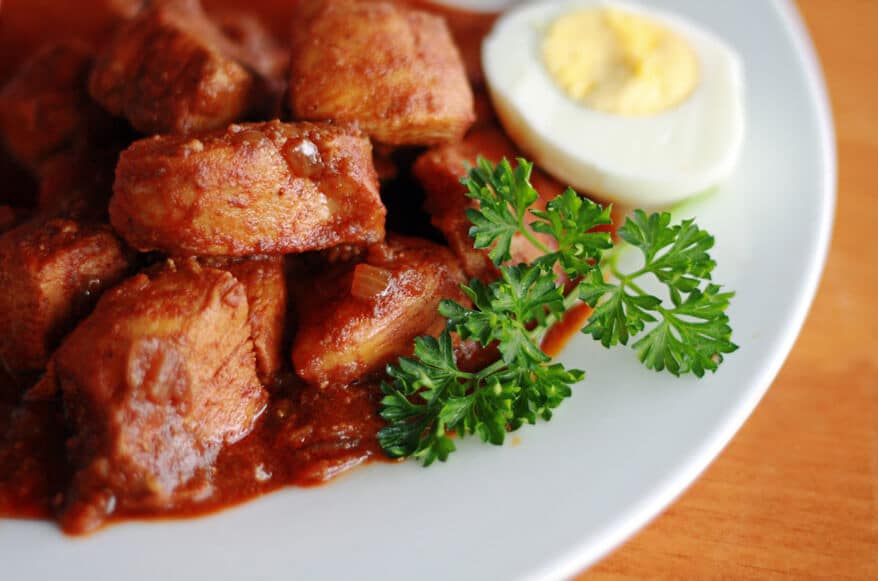
Doro Wat is one of the most famous of all African dishes. You will find it in every Ethiopian restaurant and virtually anyone who is familiar with African cuisine will have heard of it. Another version, though not as commonly known here, is Sega Wat, made with beef (fyi, you’ll find recipes online calling it Sik Sik Wat, but I’ve confirmed with the chefs of several Ethiopian restaurants that it’s Sega Wat). You can directly substitute beef for chicken and follow the same cooking instructions.
Doro Wat is traditionally made very spicy. Super spicy. Like I-don’t-know-how-Ethiopians-have-any-taste-buds-left spicy. Western adaptations are still spicy, but quite tame compared to the real deal.
This recipe for Doro Wat comes by way of request from Jared (Make a Request!). He said he has been trying for several years to find a good recipe. Jared, this recipe is both authentic and delicious – I think you’ll be very happy with it!
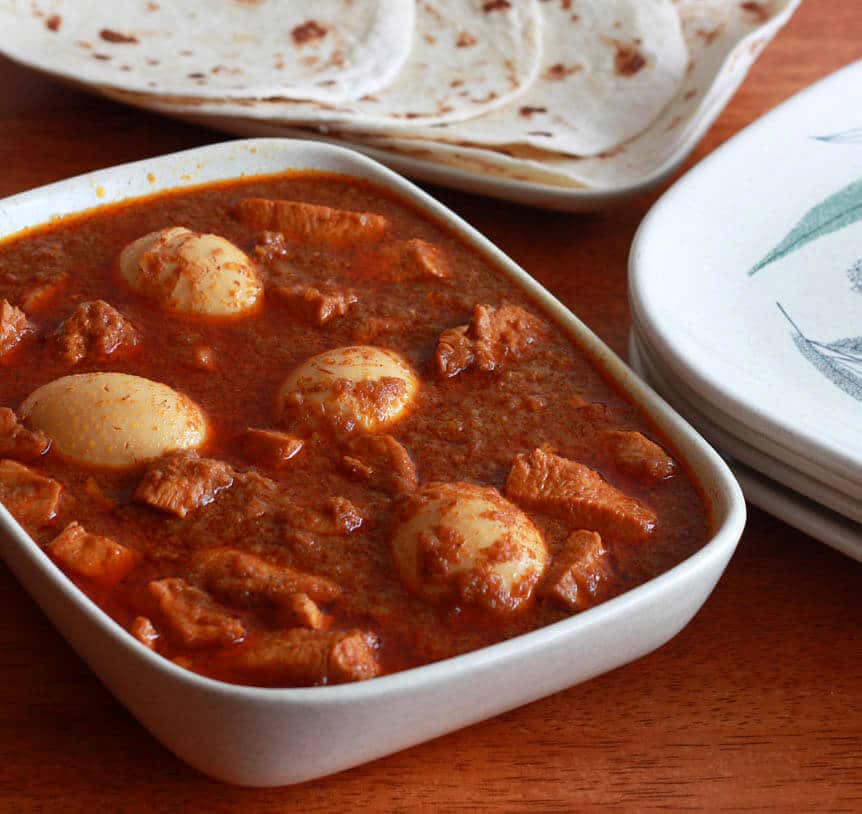
Traditionally Doro Wat is served with an Ethiopian flatbread called injera. It’s kind of a spongy pancake made with teff flour (a grain indigenous to the area), and the batter is left to ferment for up to 4 days before its used. The injera is used in place of an eating utensil and is used to scoop up the chicken stew.
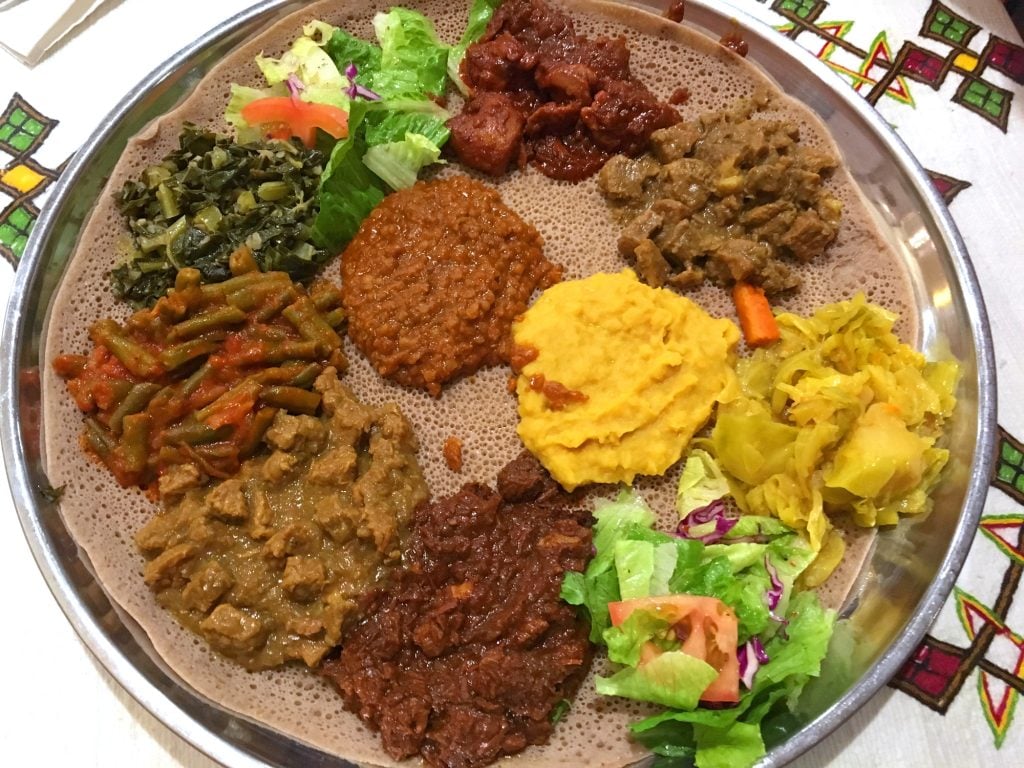
Doro Wat Key Ingredients
The key to authentic, great-tasting Doro Wat is good quality, flavorful berbere, and a very long cooking process. It can take several hours for an Ethiopian to make Doro Wat. You can cut back on the cooking time and your Doro Wat will still taste good, but it won’t taste like it’s supposed to. The magic is in the slow-cooked onions. And it takes time for the magic to happen.
A central ingredient of Doro Wat is Berbere, a fiery, bright red and flavorful Ethiopian spice blend. It is best made fresh using whole spices that are toasted and ground for maximum flavor. A combination of whole and ground spices are used as seen in the picture below.

The whole spices are toasted and ground up with the already ground spices to make a beautiful, aromatic, flavorful and spicy seasoning blend.
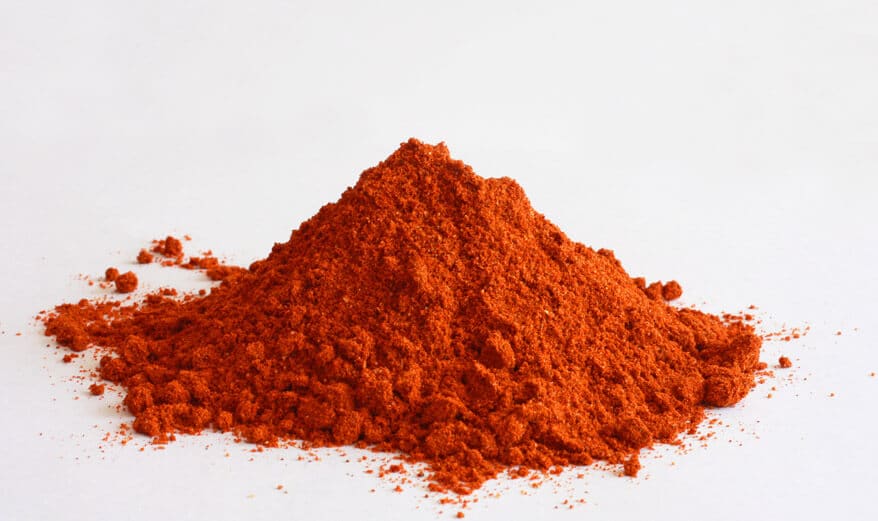
Purchasing these spices will serve you well as each of them are commonly used in a large variety of other cuisines. Stored in airtight glass jars in a dark place, they will keep a very long time. If you’d rather purchase berbere, you can find it online. You need 1/4-1/3 cup for this recipe alone, so forget the tiny 2-3 oz jars of it you usually find for sale. The best deal I’ve found for bulk berbere (and it also happens to be organic and a reputable brand) can be found HERE.
Berbere makes a great rub for meat, poultry, and fish, as well as a seasoning for stews, soups, and vegetables. It’s a great all-purpose spice, so you’ll be able to make good use of this bulk package if you decide to buy versus make your own.
Another key ingredient in Doro Wat and Ethiopian cooking at large is niter kibbeh, a seasoned clarified butter. You can find it in Indian grocery stores and well-stocked Asian markets, but as always I strongly recommend making your own for the best flavor. Check out my recipe for homemade Niter Kibbeh!

Doro Wat Recipe
Let’s get started!
Use a food processor to very finely mince the onion – you want an almost chunky puree.
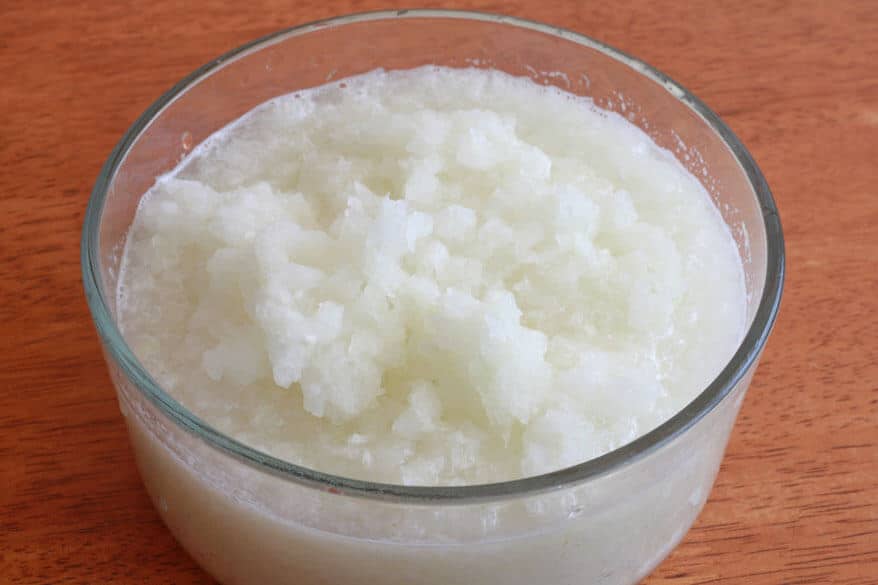
Heat 2 tablespoons of oil and 2 tablespoons of niter kibbeh in a Dutch oven and saute the onion, covered, over low heat for 45 minutes, stirring occasionally. Add more niter kibbeh if it gets too dry.
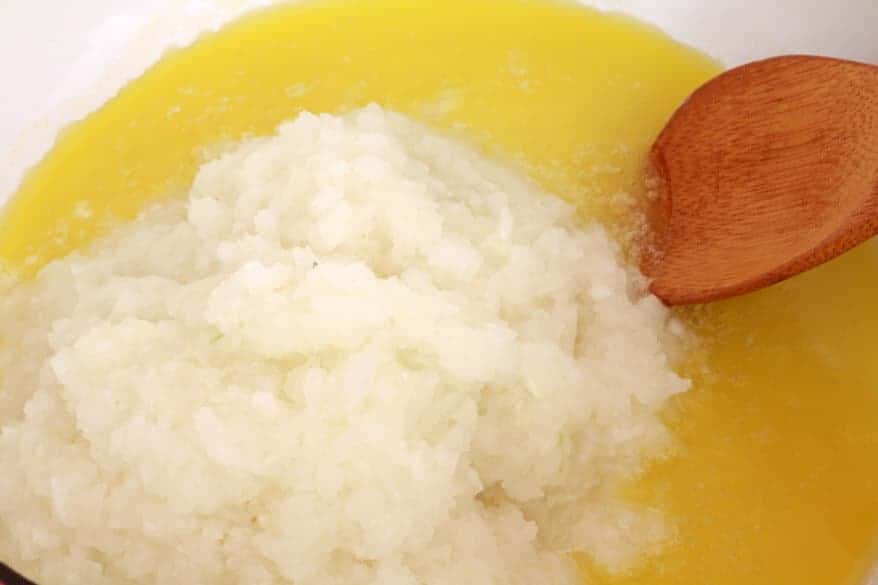
In the meantime, finely mince the garlic and ginger.
Add the garlic, ginger, and 1 tablespoon of butter. Continue to saute, covered, over low heat for another 20 minutes, stirring occasionally.
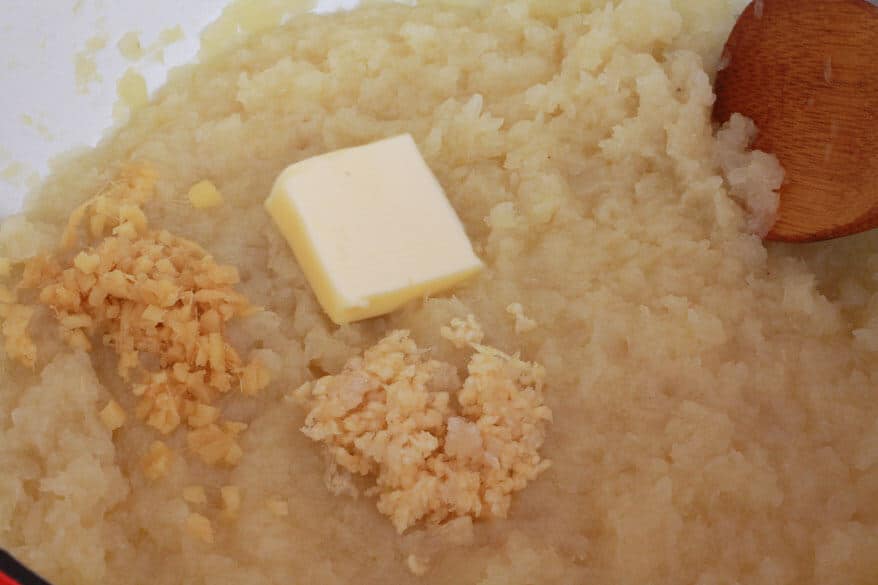
Add 4 tablespoons of berbere and 2 teaspoons salt and stir to combine.
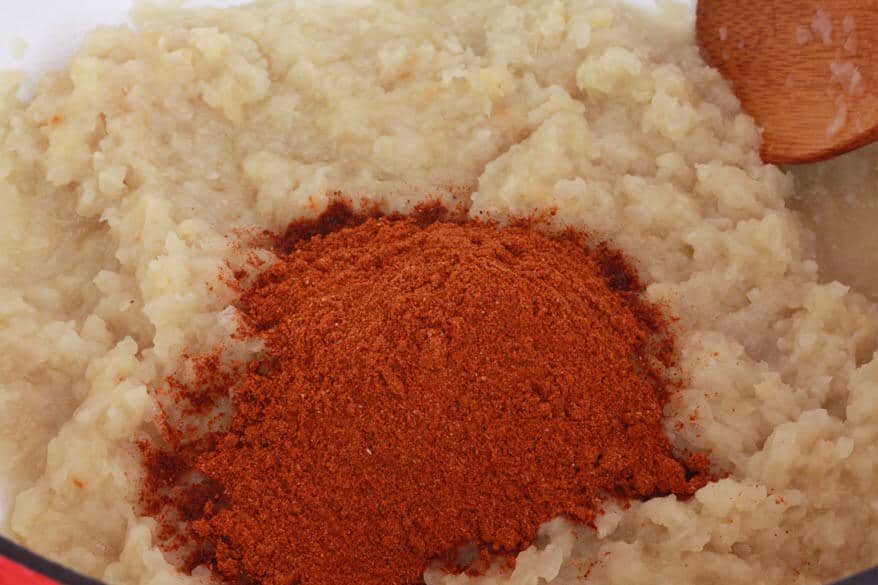
Add 2 tablespoons of butter, cover, and simmer over low heat for another 30 minutes, stirring occasionally.
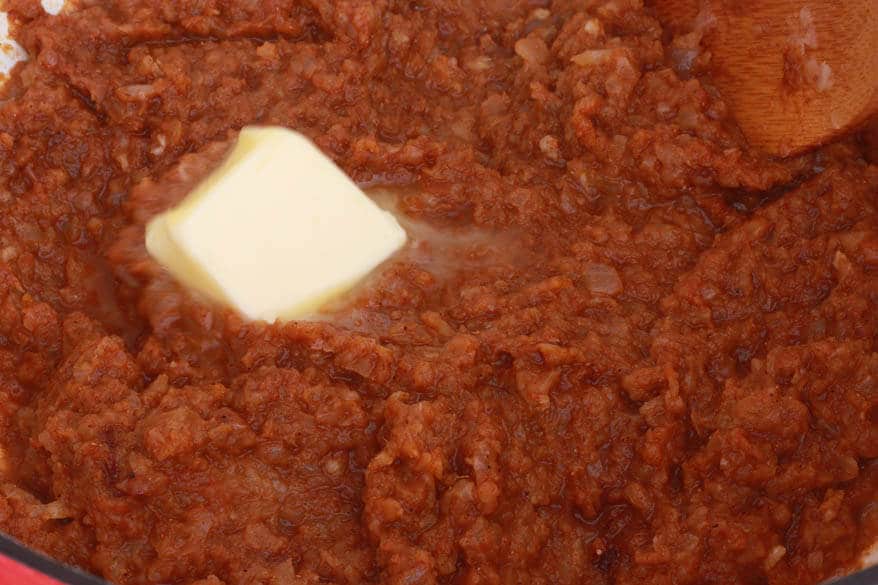
After 30 minutes you’ll have a rich and luscious sauce that’s ready for the chicken!
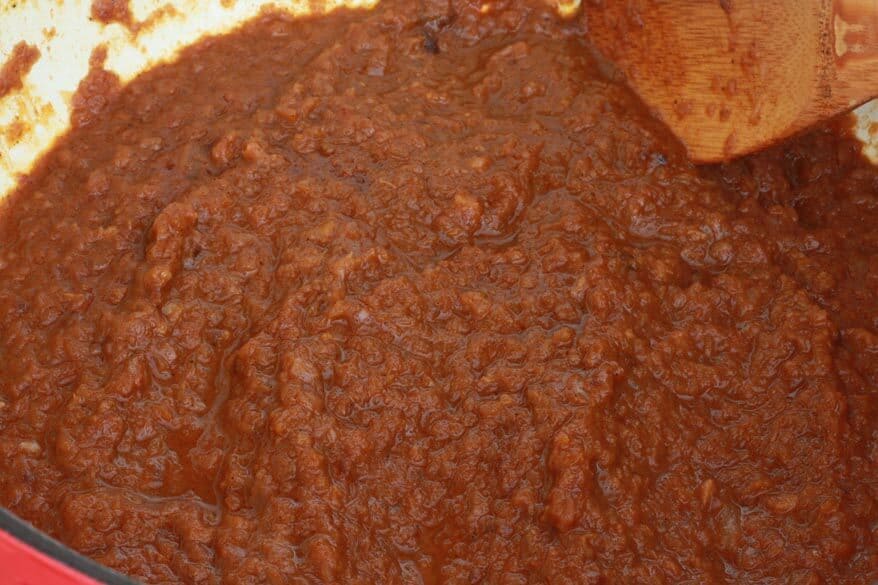
Traditionally, bone-in, skin-on chicken pieces are used. You can either use chicken thighs, cut into 1 inch chunks, or use boneless chicken breast. I used breast this time. Cut the breast into small, 1/2 inch chunks. Place the chunks in a dish with 2 tablespoons lemon juice and let sit at least 15 minutes.
Add the chicken to the sauce.
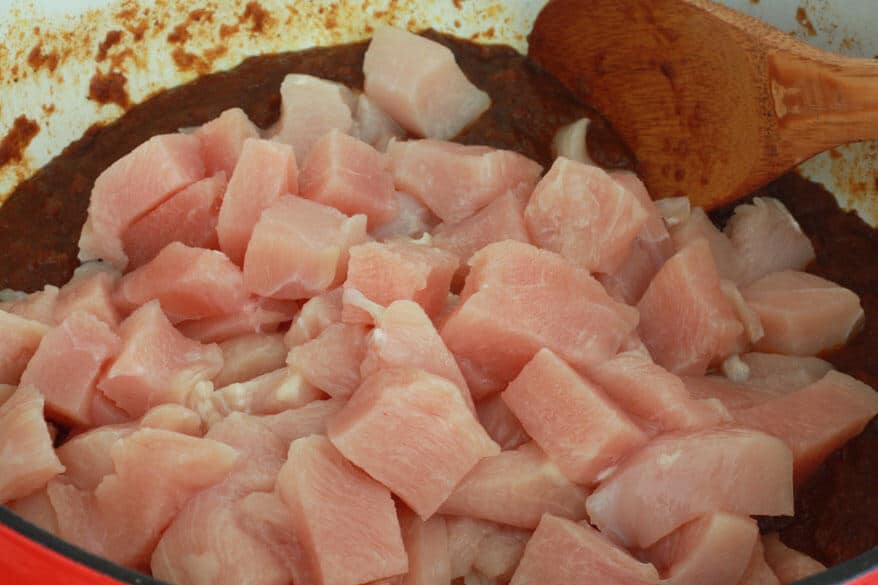
Traditionally, Tej is used, an Ethiopian honey wine. If you have access to it, use it. Alternatively you can substitute white wine with a teaspoon of honey.
Add the chicken stock, salt and honey wine to the mixture. Bring to a boil, reduce the heat to low, cover, and simmer for 45 minutes, stirring occasionally.
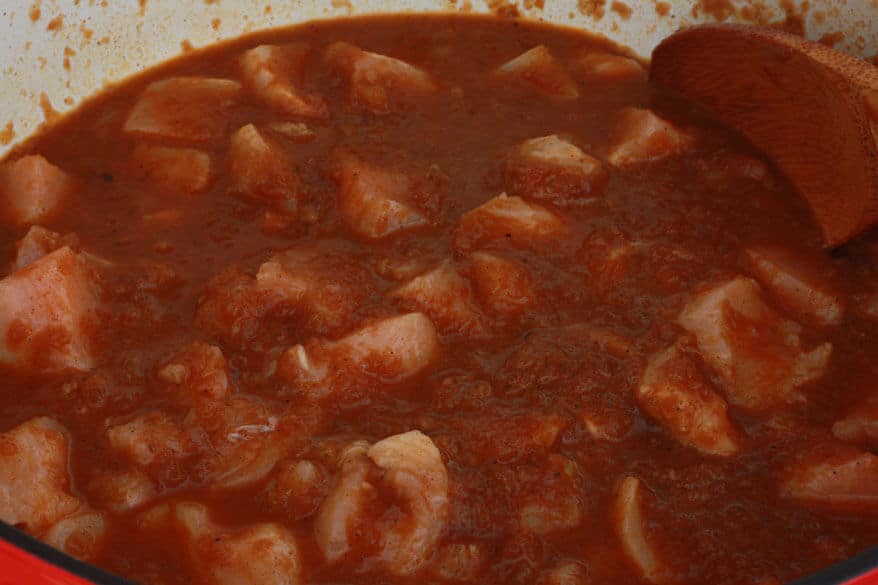
In the meantime, boil the eggs. Once the eggs have cooled enough to handle, peel and pierce them all over with a fork, about 1/4 inch deep, to allow the sauce to penetrate.
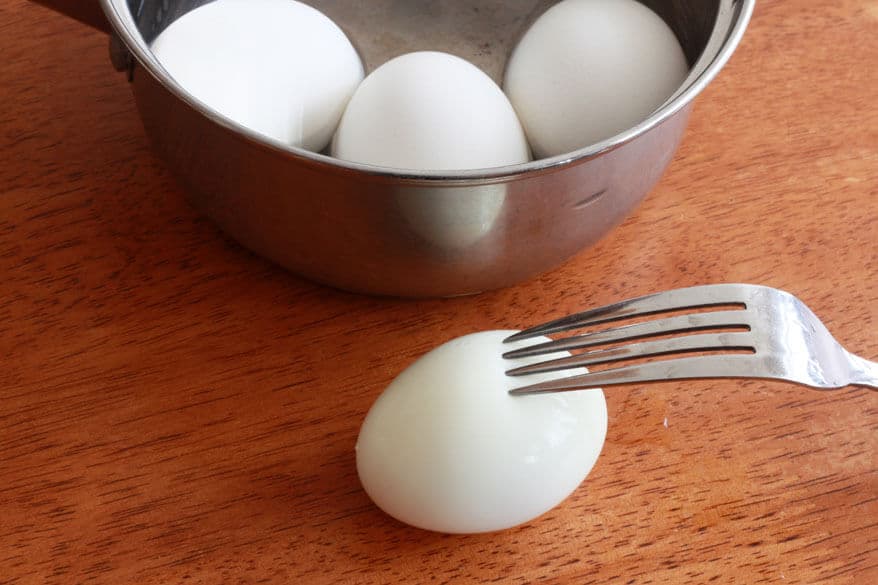
After 45 minutes you’ll have a rich, luscious spicy chicken stew ready for the eggs!
Add the eggs and continue to simmer, covered, over low heat for 15 minutes, stirring occasionally. Adjust the seasonings according to taste. Add more berbere according to heat preference.
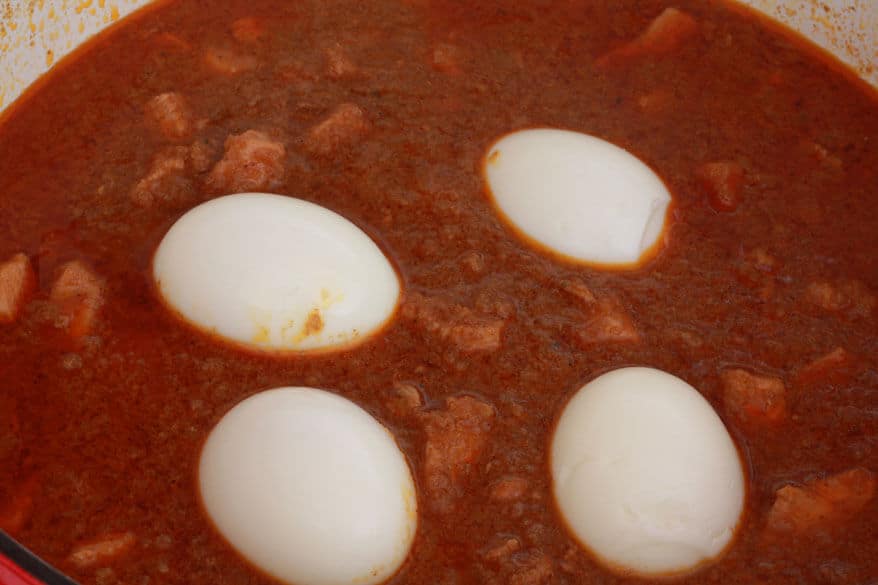

Serve with Authentic Injera (Ethiopian Flatbread).
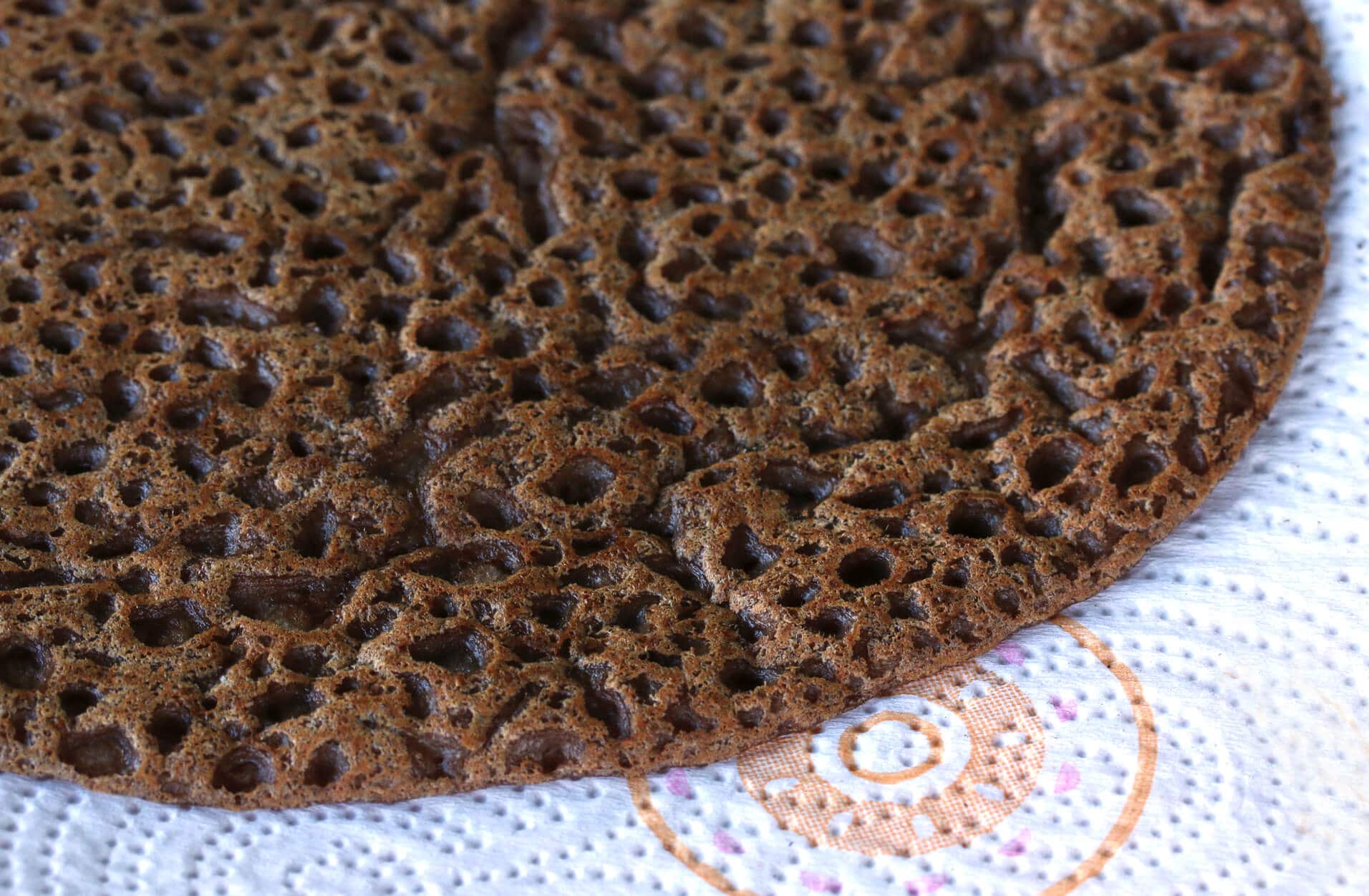
Be sure to also try our authentic Sega Wat, the famous and incredibly delicious Ethiopian spicy beef stew!
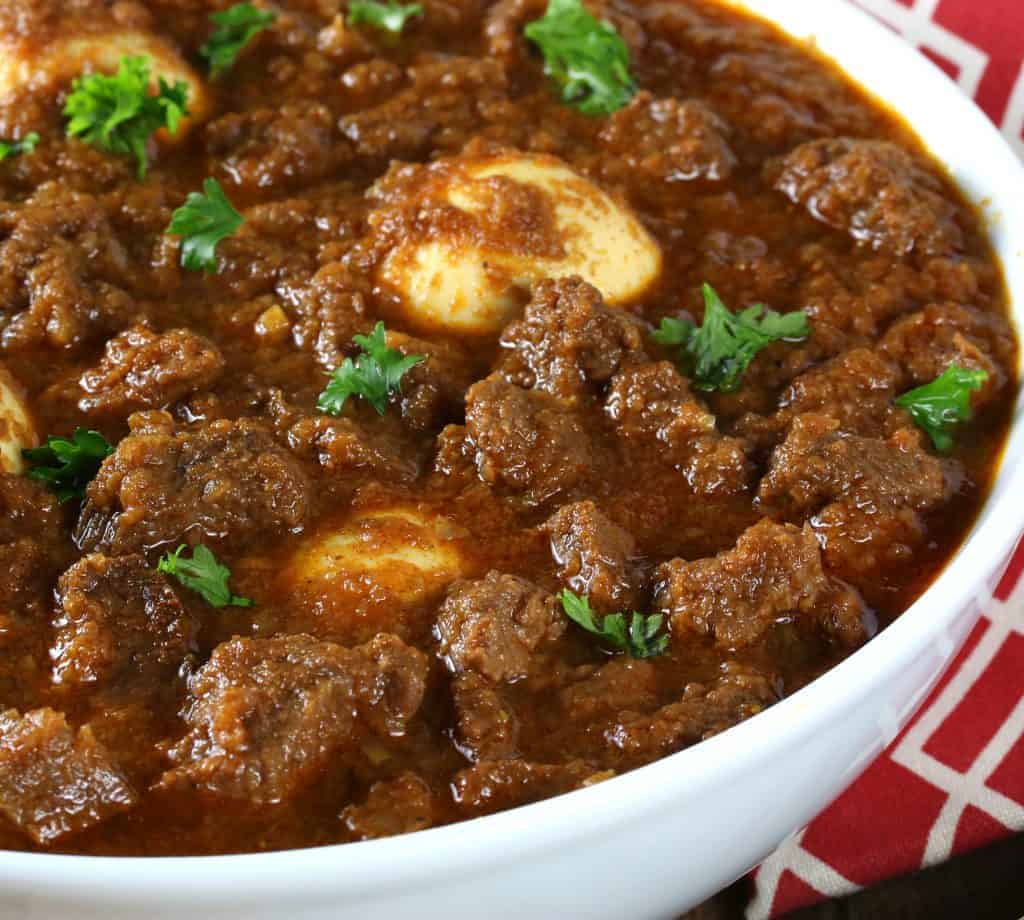
Lastly, for an authentic Ethiopian side dish to serve with your doro wat, try our Gomen (Ethiopian Collard Greens)!
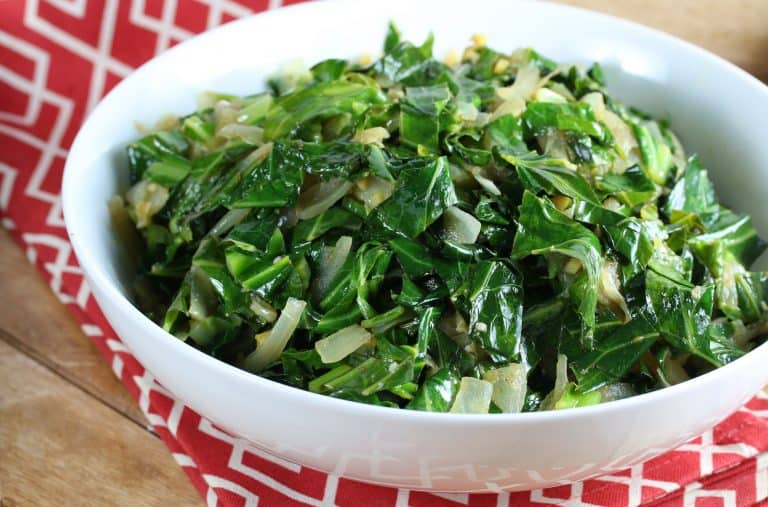
Save This Recipe
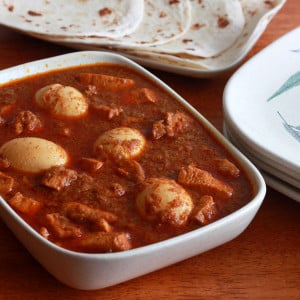
Doro Wat (Ethiopian Spiced Chicken)
Equipment
Ingredients
- 3 lbs chicken thighs , cut into 1 inch pieces, or 3 chicken breasts, cut into 1/2 inch pieces
- 2 tablespoons fresh lemon juice
- 2 tablespoons niter kibbeh
- 2 tablespoons extra virgin olive oil
- 3 cups chopped yellow onions
- 3 tablespoons butter
- 1 tablespoon finely minced garlic
- 1 tablespoon finely minced ginger
- 1/4 cup Ethiopian berbere
- or use HOMEMADE BERBERE (HIGHLY recommended!)
- 1 1/2 teaspoons salt
- 1/2 cup Tej (Ethiopian honey wine) (alternatively you can substitute white wine mixed with 1 teaspoon honey)
- 1 cup chicken stock
- 4 hard-boiled eggs , pierced all over with fork about 1/4 inch deep
Instructions
- Place the onions in a food processor and finely mince them to a chunky puree. Set aside.Place the chicken pieces in a bowl and pour lemon juice over. Let sit at room temperature for at least 30 minutes.
- Heat the niter kibbeh or butter along with the olive oil in a Dutch oven or heavy pot. Add the onions and saute, covered, over low heat for 45 minutes, stirring occasionally.Add the garlic, ginger, and 1 tablespoon butter and continue to saute, covered, for another 20 minutes, stirring occasionally. Add the berbere and the 2 remaining tablespoons of butter and saute, covered, over low heat for another 30 minutes, stirring occasionally.Add the chicken, broth, salt and wine and bring to a boil. Reduce the heat to low, cover, and simmer for 45 minutes, stirring occasionally.Adjust the seasonings, adding more berbere according to heat preference. Add the boiled eggs and simmer on low heat, covered, for another 15 minutes.
- Half or quarter the eggs and arrange on the plates with the stew. Serve hot with injera, bread or rice.
Nutrition
Originally published on The Daring Gourmet August 27, 2013



















Absolutely OUTSTANDING! I made your homemade berbere spice blend which I think is key for the best flavor. Will definitely be making this again and again! Next I’m looking forward to trying your Sega Wat!
I’m so glad, Cami, thank you!
I love this recipe and forgot to leave a comment when I first discovered it — one of your “recent” posts. I just made it 4 days ago for the 4th time. I do use Penzey’s berbere but will try from scratch when I finish the jars. I love hot spicey but admit to cutting back from 1/4 cup to 1/8 after the first time. This is such a winner and does taste and smell even better the next day — I just add more eggs to the leftovers.
I am trying your Sega Wat on Tuesday. Can’t wait and will leave a comment at that recipe. I anticipate loving it — and probably adding more berbere since it is beef.
So happy I discovered and signed up with your website. Will probably make your carrot cake for Easter.
Thanks so much, Maureen! Yes, I really, really highly recommend making your own berbere. That way you can control the heat and add more of the spice blend for a bigger flavor punch without exhaling flames :) And nothing beats the intensity of flavor in freshly made spice blends. I hope you enjoy the Sega Wat as well. Happy cooking! Best, Kimberly
This sounds wonderful, but that seems like a lot of salt for 4 servings, especially because there’s salt in the Berbere. For those of us trying to keep our sodium intake reasonable, how much can the salt be reduced without the flavor suffering?
Hi Jeff, flavor-wise it’s definitely not too salty. But if you want to cut back on the salt you can use a low-sodium chicken broth and of course reduce the salt itself. How much to reduce it by just comes down to personal preference – you can start with less, taste it, and then always add more.
I’ve always loved Doro Wat in restaurants and was excited to find your recipe online. I followed it to the letter. Unfortunately, I was ultimately disappointed. As the onion, ginger, butter, garlic, and berbere simmered together this smelled very much like I would expect and I thought I was on the right track. However, once the chicken stock and wine were added the aroma changed and i knew this was not going to be the dish I was hoping for. Other recipes I’ve seen include even more butter and no stock…I think the stock dilutes the desired flavor and texture of this dish. I also did not like having the cut-up chicken chicken rather than the bone-in pieces as it is traditionally served. Ultimately this was a much more liquid-y dish and the flavor just didn’t quite do it for me. I mean, I tasted ‘fine’, and thankfully we ate it with injera to absorb the liquid, but I would not use this recipe again.
I am making Sik Sik Wat right now, and the smells coming out of my kitchen are amazing.
Fabulous, Scott! We just went to an Ethiopian restaurant last month and had both doro wat and sega wat along with several other Ethiopian classics – such great food!
I did this according to the recipe and it turned out great! I definitely will do this again!
I would like to use vegetable stock instead of chicken stock and swap the chicken for lupin beans in order to enjoy this with a friend who avoids meat.
It would definitely be interesting to try this with lamb also. Excellent recipe, full of possibilities!
Fantastic, Mats, I’m so glad you enjoyed it, thank you! Yes, this is excellent with both lamb and beef. Thanks again!
Hi, I really liked this recipe! Just one question – is this made in the oven or on the hot-plate? Thank you in advance :)
Hi Kristina, this is made on the hot-plate/stovetop.
Hi Kimberly! Made this last night and oh, what a hit it was! The taste was out of this world! One bite and I closed my eyes and just savored the spicy, woodsy flavors. This is something I will be making often. There’s a lot of healthy aspects to the recipes, esp the garlic and spices.
I noticed that I didn’t have as much sauce as whats in your pics. I live in Colorado so, do you think there’s something I need to do for high altitude directions? Or should I add more wine and broth? I really don’t want to mess with the recipe since everything was just perfect.
Thank you so much.
Fantastic, Cass, I’m so happy to hear that, thank you! I wouldn’t think the high altitude would make that big of a difference, but who knows. If you want a little more sauce go ahead and add some more of the liquids, a little bit at a time and tasting to make sure you don’t dilute the flavor. You can also add an extra pinch or so of the berbere blend.